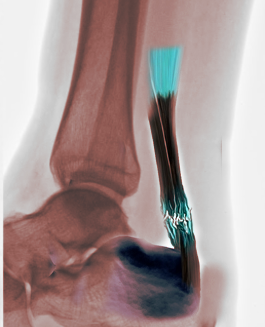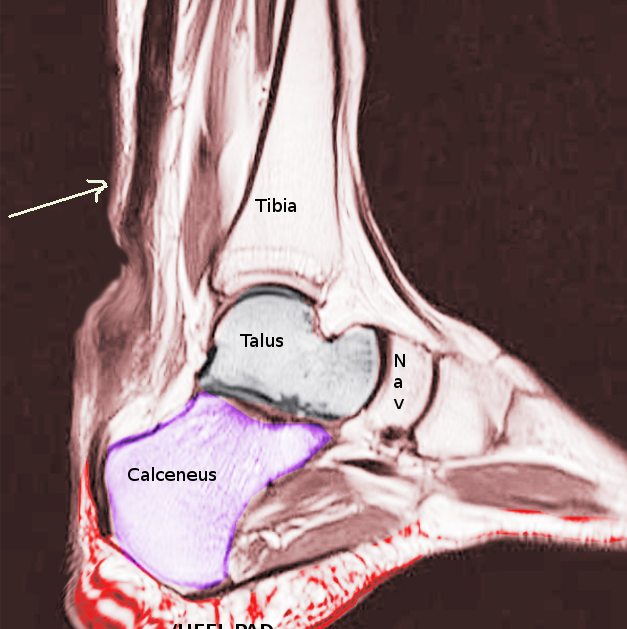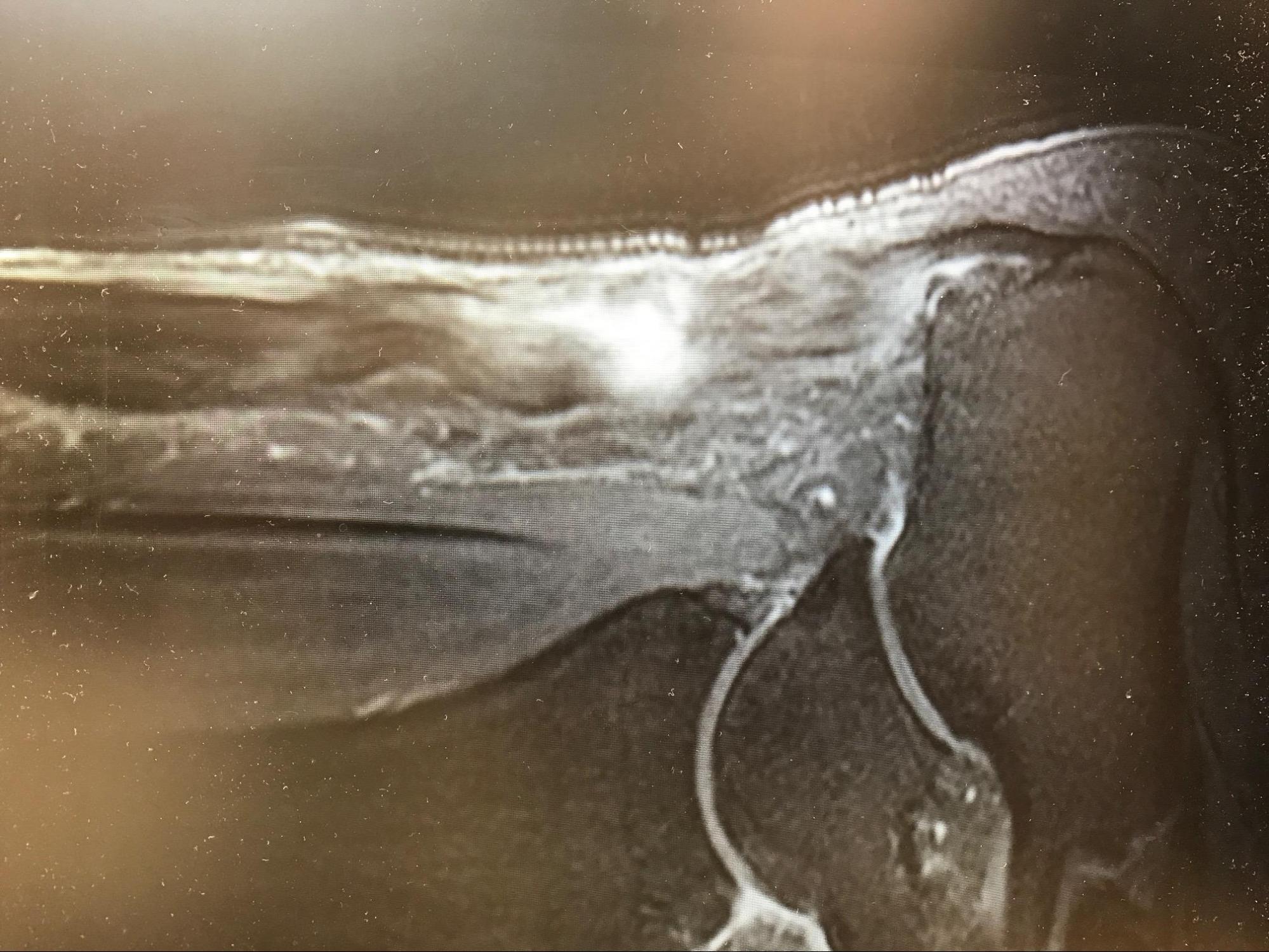[1]
Holm C, Kjaer M, Eliasson P. Achilles tendon rupture--treatment and complications: a systematic review. Scandinavian journal of medicine & science in sports. 2015 Feb:25(1):e1-10. doi: 10.1111/sms.12209. Epub 2014 Mar 20
[PubMed PMID: 24650079]
Level 1 (high-level) evidence
[2]
Carmont MR. Achilles tendon rupture: the evaluation and outcome of percutaneous and minimally invasive repair. British journal of sports medicine. 2018 Oct:52(19):1281-1282. doi: 10.1136/bjsports-2017-099002. Epub 2018 Jun 23
[PubMed PMID: 29936431]
[3]
Noback PC, Freibott CE, Tantigate D, Jang E, Greisberg JK, Wong T, Vosseller JT. Prevalence of Asymptomatic Achilles Tendinosis. Foot & ankle international. 2018 Oct:39(10):1205-1209. doi: 10.1177/1071100718778592. Epub 2018 Jun 1
[PubMed PMID: 29855207]
[4]
Haapasalo H, Peltoniemi U, Laine HJ, Kannus P, Mattila VM. Treatment of acute Achilles tendon rupture with a standardised protocol. Archives of orthopaedic and trauma surgery. 2018 Aug:138(8):1089-1096. doi: 10.1007/s00402-018-2940-y. Epub 2018 May 3
[PubMed PMID: 29725765]
[5]
Yasui Y, Tonogai I, Rosenbaum AJ, Shimozono Y, Kawano H, Kennedy JG. The Risk of Achilles Tendon Rupture in the Patients with Achilles Tendinopathy: Healthcare Database Analysis in the United States. BioMed research international. 2017:2017():7021862. doi: 10.1155/2017/7021862. Epub 2017 Apr 30
[PubMed PMID: 28540301]
[6]
Järvinen TA, Kannus P, Maffulli N, Khan KM. Achilles tendon disorders: etiology and epidemiology. Foot and ankle clinics. 2005 Jun:10(2):255-66
[PubMed PMID: 15922917]
[7]
Xergia SA, Tsarbou C, Liveris NI, Hadjithoma Μ, Tzanetakou IP. Risk factors for Achilles tendon rupture: an updated systematic review. The Physician and sportsmedicine. 2023 Dec:51(6):506-516. doi: 10.1080/00913847.2022.2085505. Epub 2022 Jun 10
[PubMed PMID: 35670156]
Level 1 (high-level) evidence
[9]
Ahmad J, Jones K. The Effect of Obesity on Surgical Treatment of Achilles Tendon Ruptures. The Journal of the American Academy of Orthopaedic Surgeons. 2017 Nov:25(11):773-779. doi: 10.5435/JAAOS-D-16-00306. Epub
[PubMed PMID: 28957986]
[10]
Egger AC, Berkowitz MJ. Achilles tendon injuries. Current reviews in musculoskeletal medicine. 2017 Mar:10(1):72-80. doi: 10.1007/s12178-017-9386-7. Epub
[PubMed PMID: 28194638]
[11]
Humbyrd CJ, Bae S, Kucirka LM, Segev DL. Incidence, Risk Factors, and Treatment of Achilles Tendon Rupture in Patients With End-Stage Renal Disease. Foot & ankle international. 2018 Jul:39(7):821-828. doi: 10.1177/1071100718762089. Epub 2018 Mar 27
[PubMed PMID: 29582683]
[12]
Meulenkamp B, Stacey D, Fergusson D, Hutton B, Mlis RS, Graham ID. Protocol for treatment of Achilles tendon ruptures; a systematic review with network meta-analysis. Systematic reviews. 2018 Dec 23:7(1):247. doi: 10.1186/s13643-018-0912-5. Epub 2018 Dec 23
[PubMed PMID: 30580763]
Level 1 (high-level) evidence
[13]
Maffulli N, Via AG, Oliva F. Chronic Achilles Tendon Rupture. The open orthopaedics journal. 2017:11():660-669. doi: 10.2174/1874325001711010660. Epub 2017 Jul 31
[PubMed PMID: 29081863]
[14]
Edama M, Takabayashi T, Yokota H, Hirabayashi R, Sekine C, Maruyama S, Otani H. Classification by degree of twisted structure of the fetal Achilles tendon. Surgical and radiologic anatomy : SRA. 2021 Oct:43(10):1691-1695. doi: 10.1007/s00276-021-02803-9. Epub 2021 Jul 14
[PubMed PMID: 34263342]
[15]
Hijazi KM, Singfield KL, Veres SP. Ultrastructural response of tendon to excessive level or duration of tensile load supports that collagen fibrils are mechanically continuous. Journal of the mechanical behavior of biomedical materials. 2019 Sep:97():30-40. doi: 10.1016/j.jmbbm.2019.05.002. Epub 2019 May 7
[PubMed PMID: 31085458]
[16]
Winnicki K, Ochała-Kłos A, Rutowicz B, Pękala PA, Tomaszewski KA. Functional anatomy, histology and biomechanics of the human Achilles tendon - A comprehensive review. Annals of anatomy = Anatomischer Anzeiger : official organ of the Anatomische Gesellschaft. 2020 May:229():151461. doi: 10.1016/j.aanat.2020.151461. Epub 2020 Jan 21
[PubMed PMID: 31978571]
[17]
Ho JO, Sawadkar P, Mudera V. A review on the use of cell therapy in the treatment of tendon disease and injuries. Journal of tissue engineering. 2014:5():2041731414549678. doi: 10.1177/2041731414549678. Epub 2014 Sep 18
[PubMed PMID: 25383170]
[18]
Nichols AEC, Oh I, Loiselle AE. Effects of Type II Diabetes Mellitus on Tendon Homeostasis and Healing. Journal of orthopaedic research : official publication of the Orthopaedic Research Society. 2020 Jan:38(1):13-22. doi: 10.1002/jor.24388. Epub 2019 Jun 24
[PubMed PMID: 31166037]
[19]
Lorimer AV, Hume PA. Achilles tendon injury risk factors associated with running. Sports medicine (Auckland, N.Z.). 2014 Oct:44(10):1459-72. doi: 10.1007/s40279-014-0209-3. Epub
[PubMed PMID: 24898814]
[20]
Cao S, Teng Z, Wang C, Zhou Q, Wang X, Ma X. Influence of Achilles tendon rupture site on surgical repair outcomes. Journal of orthopaedic surgery (Hong Kong). 2021 Jan-Apr:29(1):23094990211007616. doi: 10.1177/23094990211007616. Epub
[PubMed PMID: 33845659]
[21]
Freedman BR, Gordon JA, Soslowsky LJ. The Achilles tendon: fundamental properties and mechanisms governing healing. Muscles, ligaments and tendons journal. 2014 Apr:4(2):245-55
[PubMed PMID: 25332943]
[22]
Reiman M, Burgi C, Strube E, Prue K, Ray K, Elliott A, Goode A. The utility of clinical measures for the diagnosis of achilles tendon injuries: a systematic review with meta-analysis. Journal of athletic training. 2014 Nov-Dec:49(6):820-9. doi: 10.4085/1062-6050-49.3.36. Epub
[PubMed PMID: 25243736]
Level 1 (high-level) evidence
[23]
Garras DN, Raikin SM, Bhat SB, Taweel N, Karanjia H. MRI is unnecessary for diagnosing acute Achilles tendon ruptures: clinical diagnostic criteria. Clinical orthopaedics and related research. 2012 Aug:470(8):2268-73. doi: 10.1007/s11999-012-2355-y. Epub 2012 Apr 27
[PubMed PMID: 22538958]
[24]
Ochen Y, Beks RB, van Heijl M, Hietbrink F, Leenen LPH, van der Velde D, Heng M, van der Meijden O, Groenwold RHH, Houwert RM. Operative treatment versus nonoperative treatment of Achilles tendon ruptures: systematic review and meta-analysis. BMJ (Clinical research ed.). 2019 Jan 7:364():k5120. doi: 10.1136/bmj.k5120. Epub 2019 Jan 7
[PubMed PMID: 30617123]
Level 1 (high-level) evidence
[25]
Carmont MR, Rossi R, Scheffler S, Mei-Dan O, Beaufils P. Percutaneous & Mini Invasive Achilles tendon repair. Sports medicine, arthroscopy, rehabilitation, therapy & technology : SMARTT. 2011 Nov 14:3():28. doi: 10.1186/1758-2555-3-28. Epub 2011 Nov 14
[PubMed PMID: 22082172]
[26]
Oksanen MM, Haapasalo HH, Elo PP, Laine HJ. Hypertrophy of the flexor hallucis longus muscle after tendon transfer in patients with chronic Achilles tendon rupture. Foot and ankle surgery : official journal of the European Society of Foot and Ankle Surgeons. 2014 Dec:20(4):253-7. doi: 10.1016/j.fas.2014.06.003. Epub 2014 Jul 2
[PubMed PMID: 25457661]
[27]
Myhrvold SB, Brouwer EF, Andresen TKM, Rydevik K, Amundsen M, Grün W, Butt F, Valberg M, Ulstein S, Hoelsbrekken SE. Nonoperative or Surgical Treatment of Acute Achilles' Tendon Rupture. The New England journal of medicine. 2022 Apr 14:386(15):1409-1420. doi: 10.1056/NEJMoa2108447. Epub
[PubMed PMID: 35417636]
[28]
Deng S, Sun Z, Zhang C, Chen G, Li J. Surgical Treatment Versus Conservative Management for Acute Achilles Tendon Rupture: A Systematic Review and Meta-Analysis of Randomized Controlled Trials. The Journal of foot and ankle surgery : official publication of the American College of Foot and Ankle Surgeons. 2017 Nov-Dec:56(6):1236-1243. doi: 10.1053/j.jfas.2017.05.036. Epub
[PubMed PMID: 29079238]
Level 1 (high-level) evidence
[29]
Mansfield K, Dopke K, Koroneos Z, Bonaddio V, Adeyemo A, Aynardi M. Achilles Tendon Ruptures and Repair in Athletes-a Review of Sports-Related Achilles Injuries and Return to Play. Current reviews in musculoskeletal medicine. 2022 Oct:15(5):353-361. doi: 10.1007/s12178-022-09774-3. Epub 2022 Jul 9
[PubMed PMID: 35804260]
[30]
Indino C, D'Ambrosi R, Usuelli FG. Biologics in the Treatment of Achilles Tendon Pathologies. Foot and ankle clinics. 2019 Sep:24(3):471-493. doi: 10.1016/j.fcl.2019.04.009. Epub 2019 May 21
[PubMed PMID: 31370998]
[31]
Bachir RM, Zaia IM, Santos GS, Fonseca LFD, Boni G, Guercia RF, Ferreira GF, Lana JFSD. Bone Marrow Aspirate Concentrate Improves Outcomes in Adults With Osteochondral Dissecans of the Talus and Achilles Rupture. Arthroscopy : the journal of arthroscopic & related surgery : official publication of the Arthroscopy Association of North America and the International Arthroscopy Association. 2023 Mar:39(3):881-886. doi: 10.1016/j.arthro.2022.11.034. Epub 2022 Dec 8
[PubMed PMID: 36543662]
[32]
Stein BE, Stroh DA, Schon LC. Outcomes of acute Achilles tendon rupture repair with bone marrow aspirate concentrate augmentation. International orthopaedics. 2015 May:39(5):901-5. doi: 10.1007/s00264-015-2725-7. Epub 2015 Mar 22
[PubMed PMID: 25795246]
[33]
Lantto I, Heikkinen J, Flinkkila T, Ohtonen P, Siira P, Laine V, Leppilahti J. A Prospective Randomized Trial Comparing Surgical and Nonsurgical Treatments of Acute Achilles Tendon Ruptures. The American journal of sports medicine. 2016 Sep:44(9):2406-14. doi: 10.1177/0363546516651060. Epub 2016 Jun 15
[PubMed PMID: 27307495]
Level 1 (high-level) evidence
[34]
Park SH, Lee HS, Young KW, Seo SG. Treatment of Acute Achilles Tendon Rupture. Clinics in orthopedic surgery. 2020 Mar:12(1):1-8. doi: 10.4055/cios.2020.12.1.1. Epub 2020 Feb 13
[PubMed PMID: 32117532]
[35]
Saxena A, Giai Via A, Grävare Silbernagel K, Walther M, Anderson R, Gerdesmeyer L, Maffulli N. Current Consensus for Rehabilitation Protocols of the Surgically Repaired Acute Mid-Substance Achilles Rupture: A Systematic Review and Recommendations From the "GAIT" Study Group. The Journal of foot and ankle surgery : official publication of the American College of Foot and Ankle Surgeons. 2022 Jul-Aug:61(4):855-861. doi: 10.1053/j.jfas.2021.12.008. Epub 2021 Dec 10
[PubMed PMID: 35120805]
Level 3 (low-level) evidence
[36]
Yang X, Meng H, Quan Q, Peng J, Lu S, Wang A. Management of acute Achilles tendon ruptures: A review. Bone & joint research. 2018 Oct:7(10):561-569. doi: 10.1302/2046-3758.710.BJR-2018-0004.R2. Epub 2018 Nov 3
[PubMed PMID: 30464836]
[37]
Glazebrook M, Rubinger D. Functional Rehabilitation for Nonsurgical Treatment of Acute Achilles Tendon Rupture. Foot and ankle clinics. 2019 Sep:24(3):387-398. doi: 10.1016/j.fcl.2019.05.001. Epub 2019 Jun 22
[PubMed PMID: 31370992]
[38]
Gould HP, Bano JM, Akman JL, Fillar AL. Postoperative Rehabilitation Following Achilles Tendon Repair: A Systematic Review. Sports medicine and arthroscopy review. 2021 Jun 1:29(2):130-145. doi: 10.1097/JSA.0000000000000309. Epub
[PubMed PMID: 33972490]
Level 1 (high-level) evidence
[39]
Trofa DP, Miller JC, Jang ES, Woode DR, Greisberg JK, Vosseller JT. Professional Athletes' Return to Play and Performance After Operative Repair of an Achilles Tendon Rupture. The American journal of sports medicine. 2017 Oct:45(12):2864-2871. doi: 10.1177/0363546517713001. Epub 2017 Jun 23
[PubMed PMID: 28644678]
[40]
Dams OC, van den Akker-Scheek I, Diercks RL, Wendt KW, Zwerver J, Reininga IHF. Surveying the management of Achilles tendon ruptures in the Netherlands: lack of consensus and need for treatment guidelines. Knee surgery, sports traumatology, arthroscopy : official journal of the ESSKA. 2019 Sep:27(9):2754-2764. doi: 10.1007/s00167-018-5049-5. Epub 2018 Jul 3
[PubMed PMID: 29971520]
Level 3 (low-level) evidence
[41]
Hertel G, Götz J, Grifka J, Willers J. [Achilles tendon rupture : Current diagnostic and therapeutic standards]. Der Orthopade. 2016 Aug:45(8):709-20. doi: 10.1007/s00132-016-3287-0. Epub
[PubMed PMID: 27405457]
[42]
Song YJ, Chen G, Jia SH, Xu WB, Hua YH. Good outcomes at mid-term following the reconstruction of chronic Achilles tendon rupture with semitendinosus allograft. Knee surgery, sports traumatology, arthroscopy : official journal of the ESSKA. 2020 May:28(5):1619-1624. doi: 10.1007/s00167-018-5113-1. Epub 2018 Aug 20
[PubMed PMID: 30128686]
[43]
Westin O, Nilsson Helander K, Grävare Silbernagel K, Samuelsson K, Brorsson A, Karlsson J. Patients with an Achilles tendon re-rupture have long-term functional deficits and worse patient-reported outcome than primary ruptures. Knee surgery, sports traumatology, arthroscopy : official journal of the ESSKA. 2018 Oct:26(10):3063-3072. doi: 10.1007/s00167-018-4952-0. Epub 2018 Apr 24
[PubMed PMID: 29691618]
[44]
Becher C, Donner S, Brucker J, Daniilidis K, Thermann H. Outcome after operative treatment for chronic versus acute Achilles tendon rupture - A comparative analysis. Foot and ankle surgery : official journal of the European Society of Foot and Ankle Surgeons. 2018 Apr:24(2):110-114. doi: 10.1016/j.fas.2016.12.003. Epub 2017 Jan 4
[PubMed PMID: 29409231]
Level 2 (mid-level) evidence



